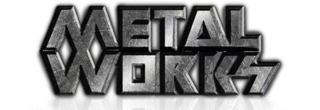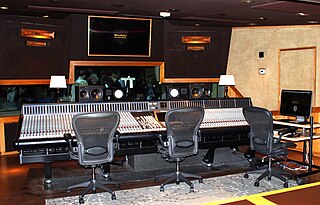
A recording studio is a specialized facility for recording and mixing of instrumental or vocal musical performances, spoken words, and other sounds. They range in size from a small in-home project studio large enough to record a single singer-guitarist, to a large building with space for a full orchestra of 100 or more musicians. Ideally, both the recording and monitoring spaces are specially designed by an acoustician or audio engineer to achieve optimum acoustic properties.

Mastering, a form of audio post production, is the process of preparing and transferring recorded audio from a source containing the final mix to a data storage device, the source from which all copies will be produced. In recent years, digital masters have become usual, although analog masters—such as audio tapes—are still being used by the manufacturing industry, particularly by a few engineers who specialize in analog mastering.

The Hit Factory is a recording studio in New York City owned and operated by Troy Germano. Since 1969, The Hit Factory recording studios have existed in six different locations in New York City as well as facilities in London and Miami. Today the studios are located at 676 Broadway in the Noho neighborhood of New York City.

United Western Recorders was a two-building recording studio complex in Hollywood that was one of the most successful independent recording studios of the 1960s. The complex merged neighboring studios United Recording Corp. on 6050 Sunset Boulevard and Western Studio on 6000 Sunset Boulevard.

Steve Albini was an American musician and audio engineer best known as the frontman for the influential post-hardcore and noise rock bands Big Black (1981–1987) and Shellac (1992–2024). He was the founder, owner, and principal engineer at Electrical Audio, a recording studio complex in Chicago, Illinois. There he oversaw the recording for several thousand singles, EPs and albums for numerous bands; notably Nirvana, Pixies, the Breeders, PJ Harvey, the Jesus Lizard and Jimmy Page and Robert Plant.
Harrison Audio Consoles is an international company based in Nashville, Tennessee that manufactures high-end mixing consoles, Digital Audio Workstations (DAW), audio plugins, and other audio technologies for the post-production, video production, broadcast, sound reinforcement and music recording industries. The company is renowned as an industry innovation for its "in-line" mixing console design that has subsequently become the standard for nearly every large-format music console. Over 1,500 Harrison consoles have been installed worldwide, presenting a significant percentage of the overall world market share for high-end audio consoles. The company founder, Dave Harrison, was inducted as a Fellow in the Audio Engineering Society for this technical contribution of the recording industry and in particular the first 32-bus "in-line" console.

Metalworks Studios is a music recording studio in Mississauga, Ontario, Canada. It was established in 1978 by Gil Moore of the Canadian rock group, Triumph. Over a span of 40 years, Metalworks has been the recipient of Canadian Music Week's 'Studio of the Year' 17 times. Since 1978, Metalworks Studios has expanded into a six studio facility offering in-house tracking, mixing and mastering, as well as video editing and DVD authoring.

Stem-mixing is a method of mixing audio material based on creating groups of audio tracks and processing them separately prior to combining them into a final master mix. Stems are also sometimes referred to as submixes, subgroups, or buses.
Unique Recording Studios was a five-room recording studio operating near Times Square in New York City from 1978 until 2004. Founders and co-owners Bobby Nathan and Joanne Georgio-Nathan installed the first Otari 24-track tape deck in New York. The studio was known for its extensive collection of synthesizers, which attracted Steve Winwood, who jammed for many hours in the process of creating his multi-Grammy winning album Back in the High Life (1986) at Unique.
Cherry Beach Sound is a recording studio in the Port Lands of Toronto, Ontario, Canada at 33 Villiers Street. It is located in Toronto's growing film district and is also a successful audio post-production house; TV, radio, and film commercials and or advertisements are often mixed in stereo or 5.1 surround sound.
An audio signal is a representation of sound, typically using either a changing level of electrical voltage for analog signals, or a series of binary numbers for digital signals. Audio signals have frequencies in the audio frequency range of roughly 20 to 20,000 Hz, which corresponds to the lower and upper limits of human hearing. Audio signals may be synthesized directly, or may originate at a transducer such as a microphone, musical instrument pickup, phonograph cartridge, or tape head. Loudspeakers or headphones convert an electrical audio signal back into sound.

Capitol Studios is a recording studio located at the landmark Capitol Records Tower in Hollywood, California, United States. The studios, which opened in 1956, were initially the primary recording studios for the American record label Capitol Records. While they are still regularly used by Capitol recording artists, the facilities began to be made available to artists outside the label during the late 1960s to the early 1970s. The studios are owned by Universal Music Group, the parent company of Capitol Music Group.

Westlake Recording Studios is a music recording studio in West Hollywood, California.

Big Blue Meenie was a production house in Jersey City, New Jersey.

An audio engineer helps to produce a recording or a live performance, balancing and adjusting sound sources using equalization, dynamics processing and audio effects, mixing, reproduction, and reinforcement of sound. Audio engineers work on the "technical aspect of recording—the placing of microphones, pre-amp knobs, the setting of levels. The physical recording of any project is done by an engineer…"

In sound recording and reproduction, audio mixing is the process of optimizing and combining multitrack recordings into a final mono, stereo or surround sound product. In the process of combining the separate tracks, their relative levels are adjusted and balanced and various processes such as equalization and compression are commonly applied to individual tracks, groups of tracks, and the overall mix. In stereo and surround sound mixing, the placement of the tracks within the stereo field are adjusted and balanced. Audio mixing techniques and approaches vary widely and have a significant influence on the final product.
The Conservatory of Recording Arts and Sciences is a private for-profit technical school specializing in audio recording, audio engineering and production education with its main location in Tempe and a satellite campus in Gilbert, Arizona. It is accredited by the Accrediting Commission of Career Schools and Colleges and approved by the Arizona State Board of Private Postsecondary Education.
Quad Studios Nashville was a four-studio recording facility established as Quadrafonic Sound Studio in 1971 on Music Row in Nashville, Tennessee, US. The studio was the location of numerous notable recording sessions, including Neil Young's Harvest, Jimmy Buffett's "Margaritaville", Joan Baez' "The Night They Drove Old Dixie Down", and Dobie Gray's "Drift Away". The studio's location has been the home of Sienna Recording Studios since 2014.
Trackdown (Trackdown Digital Pty Ltd) is an independent Australian audio post and music services facility for the film, television, music, and multimedia industries. Founded in 1984 by Simon Leadley and Geoff Watson, they provide dedicated music editing services for feature films. Their facilities include an orchestral scoring stage, 5.1 control room, ADR and Foley recording studios, 5.1 film pre-mix rooms, 5.1 mix rooms, and five Pro Tools editing suites. Trackdown is located in The Entertainment Quarter at Moore Park.
25th Street Recording is a music recording studio in Oakland, California, United States.












